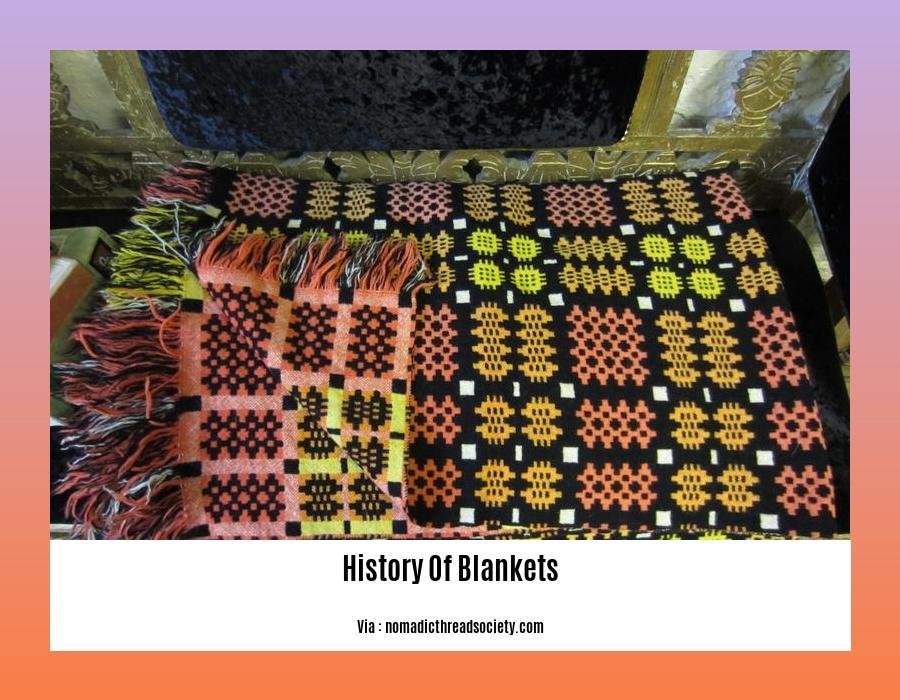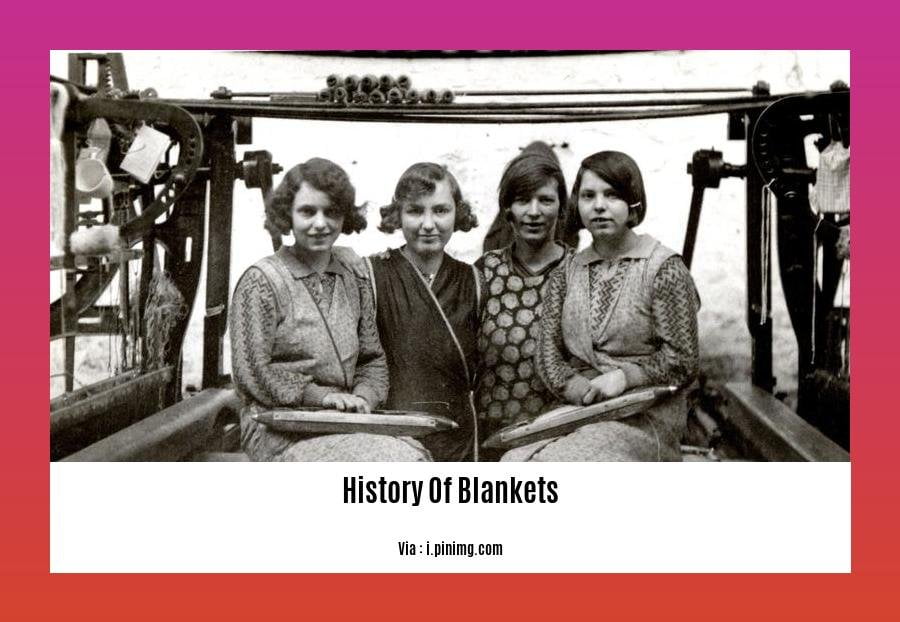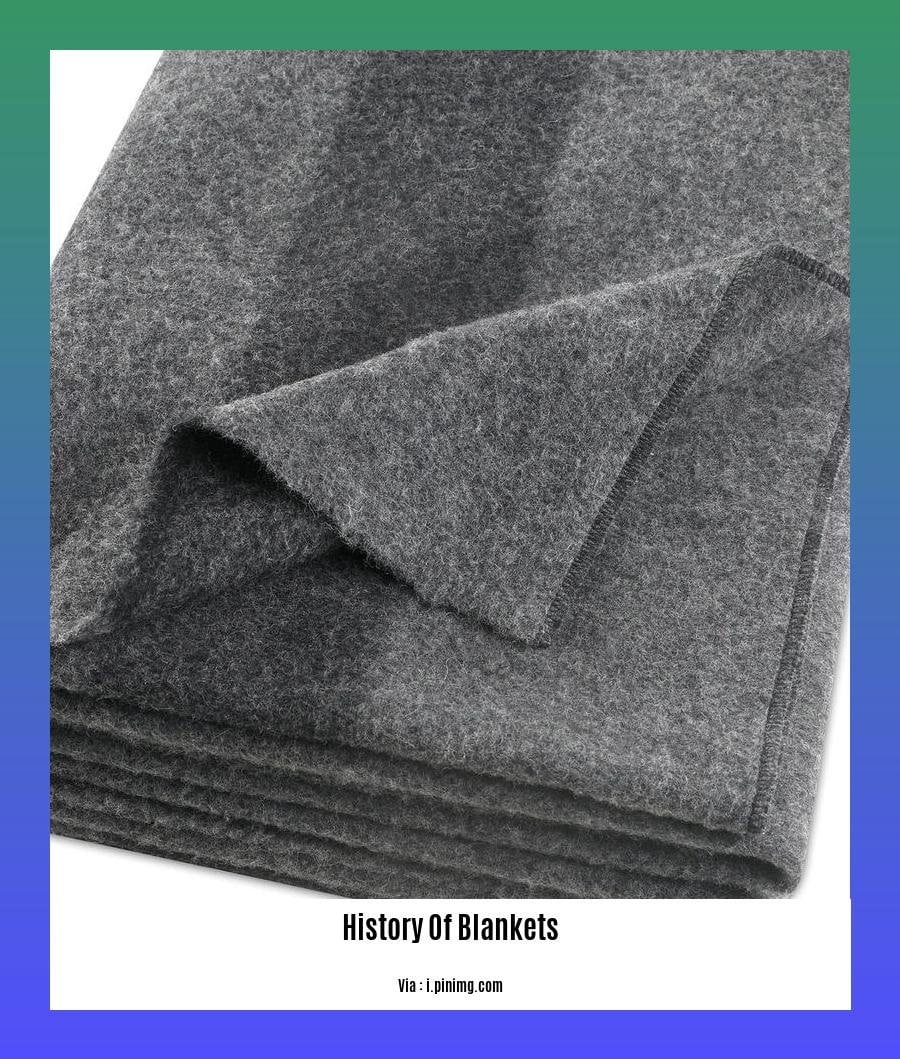Within the vast tapestry of human history, one thread that weaves a story of comfort, warmth, and cultural expression is that of the blanket. From humble beginnings in prehistoric caves to the intricate designs of ancient Egyptian tombs, blankets have been an indispensable part of our journey through time and culture. Join us as we embark on a fascinating voyage of discovery, unraveling the history of blankets, exploring their evolution across civilizations, and uncovering the stories they hold.
Key Takeaways:
Earliest blanket-like artifacts date back to around 2800 BCE from Ancient Egypt.
First woolen blankets were made around 1000 BCE in China and 500 CE in Europe.
The term “blanket” was coined by Thomas Blanket in the 14th century, who set up the first large-scale production of woolen blankets.
History of Blankets:


Blankets have journeyed with humans throughout history, providing warmth, comfort, and cultural expression. Their evolution is a tapestry of innovation, necessity, and artistry, intertwined with the tales of diverse civilizations.
Earliest Blankets:
Early humans sought refuge from the elements using animal skins and furs. Around 2800 BCE, ancient Egyptians fashioned rudimentary blankets from goat hair, heralding the earliest evidence of blanket-like textiles.
The Rise of Wool:
Around 1000 BCE, Chinese artisans pioneered the creation of woolen blankets. Wool, with its superior insulation and breathability, became the textile of choice for blankets in colder climates.
Europe Embraces Wool:
Around 500 CE, the use of wool for blankets spread to Europe, where it thrived in the temperate climate. Woolen blankets became an integral part of European households, providing warmth and comfort during chilly nights.
The Origin of the Term “Blanket”:
In the 14th century, Thomas Blanket, a Flemish weaver, revolutionized blanket production in Bristol, England. He established the first large-scale woolen blanket factory, earning him the distinction of being the namesake for these ubiquitous textiles.
From Necessity to Cultural Symbol:
Blankets transcended their functional purpose, becoming symbols of cultural identity and status. In many Native American tribes, blankets were intricately woven with colorful patterns, each telling a unique story of the weaver’s heritage.
Industrial Revolution and Mass Production:
The Industrial Revolution ushered in mass production techniques, making blankets more accessible and affordable. This led to a proliferation of styles and designs, catering to diverse preferences and budgets.
Contemporary Blankets:
Today, blankets continue to evolve, incorporating new materials, technologies, and design aesthetics. From electric blankets providing warmth on demand to lightweight, packable travel blankets, they remain indispensable companions, offering comfort, style, and a touch of history in every cozy embrace.
Ever wonder how the boat began its journey across the sea? Discover the fascinating history of boats and see how it transformed sailing as we know it.
Interested in the evolution of boxing equipment? Explore the intriguing history of boxing gloves and witness the remarkable changes that shaped the sport.
Who Invented Blankets? Unraveling the Enigma
Blankets, those warm and comforting companions of our beds, have a rich history that dates back to ancient civilizations. As humans sought solace from the cold, they turned to various materials and techniques to create these indispensable items. Let’s embark on a journey to uncover the origins of blankets and the people who played a pivotal role in their invention.
Key Takeaways:
Ancient Origins: Early humans relied on animal skins and furs to keep warm during chilly nights. These rudimentary blankets offered protection against the elements, laying the foundation for future developments.
Woven Wonders: Around 1000 BCE, the Chinese made significant strides in blanket-making by weaving wool into warm and durable blankets.
European Innovations: In 500 CE, Europeans joined the blanket-making revolution, utilizing wool to create their own versions of these cozy companions.
Thomas Blanket: In the 14th century, Thomas Blanket, a Flemish weaver residing in Bristol, England, played a pivotal role in popularizing blankets. His expertise in weaving a specific type of fabric, known as blanket fabric, earned him recognition as the inventor of blankets.
Evolving Techniques: Over the centuries, blanket-making techniques evolved, with advancements in weaving, the use of cotton and wool, and the introduction of new designs and patterns.
Mass Production: The Industrial Revolution ushered in mass production of blankets, making them more accessible and affordable for the general population.
Citations:
[1] https://en.wikipedia.org/wiki/Blanket
[2]
FAQ
Q1: What were the earliest blankets like?
A1: The earliest blankets, dating back to around 2800 BCE in Ancient Egypt, were made from goat hair and were likely used for warmth and protection during the night.
Q2: When were the first woolen blankets made?
A2: The first woolen blankets were made in China around 1000 BCE and in Europe around 500 CE. These blankets were made from sheep’s wool and were likely used for both warmth and comfort.
Q3: Who invented the term “blanket”?
A3: The term “blanket” was coined by Thomas Blanket, a Flemish weaver who lived in Bristol, England, in the 14th century. Blanket is credited with developing a specific type of blanket fabric that was used to make warm, soft, and durable blankets.
Q4: What was the origin of the word “blanket”?
A4: The word “blanket” comes from a specific fabric called blanke, which was a heavily napped undyed woolen weave. The term blanke is thought to have originated from the French term “blanquette,” which in turn derives from the English term “white.”
Q5: What materials were used to make blankets in prehistoric times?
A5: In prehistoric times, blankets were made from a variety of materials, including animal skins, furs, and woven plant fibers. These blankets were used for warmth and protection from the elements, and were often decorated with intricate designs.
- Star Ring Trends: Etsy vs Amazon - March 28, 2025
- Boost Pollinator Habitats: Baby Blue Eyes Sustainable Farming Guide - March 28, 2025
- Protect Big Black Bears: Effective Conservation Strategies - March 28, 2025
















